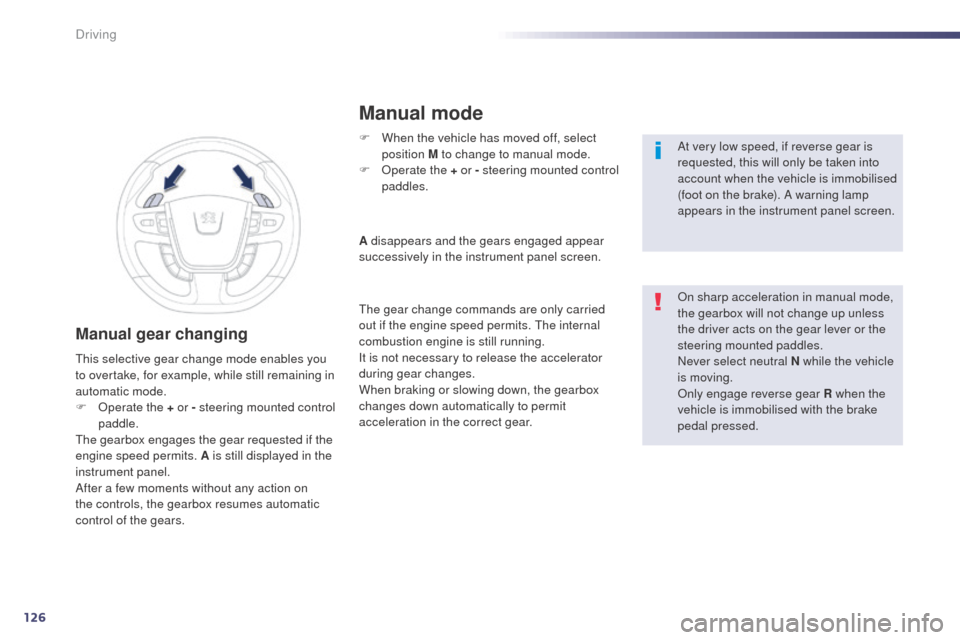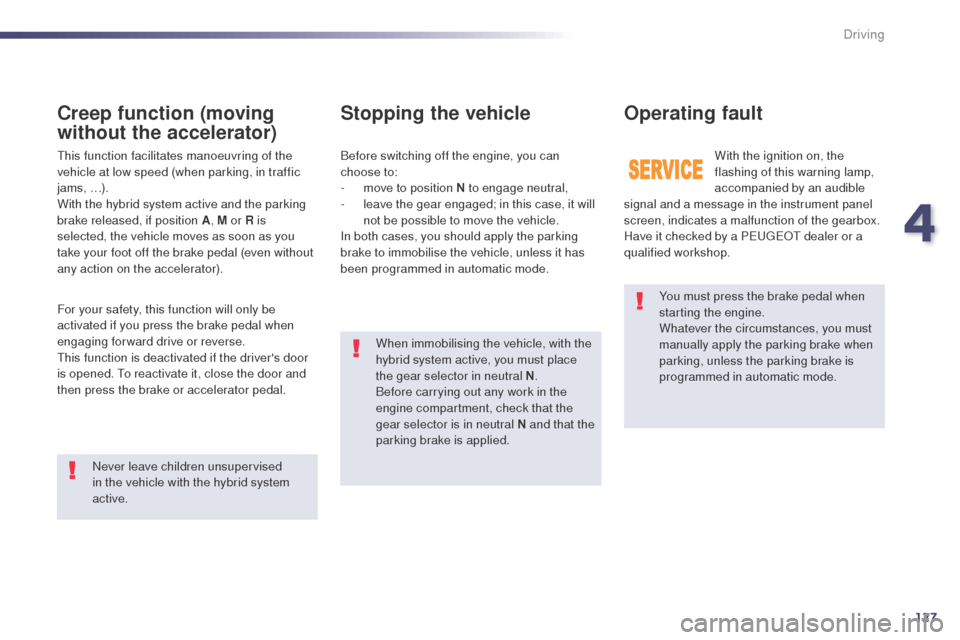Page 122 of 338
120
508RXH_en_Chap04_conduite_ed01-2014
Emergency braking
In the event of a failure of the main service
brake, a continuous pull on the control lever A
will stop the vehicle.
th
e dynamic stability control provides stability
during emergency braking.
If the emergency braking malfunctions,
a
message will be displayed. If a failure of the DSC system is
signalled by the lighting of this
warning lamp, then braking stability is
not guaranteed.
th
e emergency braking must only be
used in exceptional circumstances.
In this event, stability must be assured by the
driver by repeating alternate "pull-release"
actions on the control lever A
.On the event of a battery failure,
the parking brake can no longer be
operated.
As a safety measure, if the parking
brake is not applied, immobilise the
vehicle by engaging a gear or placing a
chock against one of the wheels.
Contact a P
e
uge
Ot
dealer or a
qualified workshop.
Driving
Page 123 of 338

121
508RXH_en_Chap04_conduite_ed01-2014
Operating faults
If the electric parking brake fault warning lamp comes on together with one or more of the warning lamps presented in these tables, place the vehicle in
a safe condition (on level ground, gear engaged) and contact a PeugeOt dealer or a qualified workshop without delay.
Situations Consequences
Display of the message " Parking brake fault" and of the following
warning lamps: -
t
h
e automatic functions are deactivated.
-
H
ill start assist is not available.
-
t
h
e electric parking brake can only be used manually.
Display of the message " Parking brake fault" and of the following
warning lamps: -
M
anual release of the electric parking brake is only available by
pressing the accelerator pedal and releasing the control lever.
-
H
ill start assist is not available.
-
t
h
e automatic functions and the manual application are still
available.
Display of the message " Parking brake fault" and of the following
warning lamps: -
t
h
e automatic functions are deactivated.
-
H
ill start assist is not available.
4
Driving
Page 124 of 338

122
508RXH_en_Chap04_conduite_ed01-2014
SituationsConsequences
to a
pply the electric parking brake:
F
i
mmobilise the vehicle and switch off the ignition.
F
p
ull the control for at least 5 seconds or until application is complete.
F
s
witch on the ignition and check that the electric parking brake
warning lamps come on.
th
e application is slower than during normal operation.
to r
elease the electric parking brake:
F
s
witch on the ignition.
F
p
ush the control lever and hold it for approximately 3 seconds then
release it.
If the braking warning lamp is flashing or if the warning lamps do not
come on with the ignition on, these procedures will not work. Place the
vehicle on level ground and have it checked by a P
e
uge
Ot
dealer or a
qualified workshop.
and possibly
flashing
Display of the message "
Parking brake fault" and of the following
warning lamps: -
O
nly the automatic application on switching off the engine and
automatic release on acceleration functions are available.
-
t
h
e manual application/release of the electric parking brake and the
emergency braking are not available.
and possibly
flashing
Display of the message " Battery charge fault". -
Y
ou must stop as soon as it is safe to do so. Switch off and
immobilise your vehicle (if necessary, place the a chock under a
wheel).
-
A
pply the electric parking brake before switching off the engine.
Driving
Page 128 of 338

126
508RXH_en_Chap04_conduite_ed01-2014
Manual gear changing
F When the vehicle has moved off, select position M to change to manual mode.
F
O
perate the + or - steering mounted control
paddles. At very low speed, if reverse gear is
requested, this will only be taken into
account when the vehicle is immobilised
(foot on the brake). A warning lamp
appears in the instrument panel screen.
On sharp acceleration in manual mode,
the gearbox will not change up unless
the driver acts on the gear lever or the
steering mounted paddles.
Never select neutral N while the vehicle
is moving.
Only engage reverse gear R when the
vehicle is immobilised with the brake
pedal pressed.
A disappears and the gears engaged appear
successively in the instrument panel screen.
th
e gear change commands are only carried
out if the engine speed permits.
t
h
e internal
combustion engine is still running.
It is not necessary to release the accelerator
during gear changes.
When braking or slowing down, the gearbox
changes down automatically to permit
acceleration in the correct gear.
th
is selective gear change mode enables you
to overtake, for example, while still remaining in
automatic mode.
F
O
perate the + or - steering mounted control
paddle.
th
e gearbox engages the gear requested if the
engine speed permits. A is still displayed in the
instrument panel.
After a few moments without any action on
the controls, the gearbox resumes automatic
control of the gears.
Manual mode
Driving
Page 129 of 338

127
508RXH_en_Chap04_conduite_ed01-2014
You must press the brake pedal when
starting the engine.
Whatever the circumstances, you must
manually apply the parking brake when
parking, unless the parking brake is
programmed in automatic mode.
When immobilising the vehicle, with the
hybrid system active, you must place
the gear selector in neutral N
.
Before carrying out any work in the
engine compartment, check that the
gear selector is in neutral N and that the
parking brake is applied.
Stopping the vehicle
With the ignition on, the
flashing of this warning lamp,
accompanied by an audible
signal and a message in the instrument panel
screen, indicates a malfunction of the gearbox.
Have it checked by a P
e
uge
Ot
dealer or a
qualified workshop.
Before switching off the engine, you can
choose to:
-
m
ove to position N to engage neutral,
-
l
eave the gear engaged; in this case, it will
not be possible to move the vehicle.
In both cases, you should apply the parking
brake to immobilise the vehicle, unless it has
been programmed in automatic mode.
Operating fault
this function facilitates manoeuvring of the
vehicle at low speed (when parking, in traffic
jams, …).
With the hybrid system active and the parking
brake released, if position A , M or R is
selected, the vehicle moves as soon as you
take your foot off the brake pedal (even without
any action on the accelerator).
Creep function (moving
without the accelerator)
Never leave children unsupervised
in the vehicle with the hybrid system
active.
For your safety, this function will only be
activated if you press the brake pedal when
engaging forward drive or reverse.
th
is function is deactivated if the driver's door
is opened. t
o r
eactivate it, close the door and
then press the brake or accelerator pedal.
4
Driving
Page 130 of 338

128
508RXH_en_Chap04_conduite_ed01-2014
Hill start assist
System which keeps your vehicle immobilised
temporarily (approximately 2 seconds) when
starting on a gradient, the time it takes to
move your foot from the brake pedal to the
accelerator pedal.
th
is function is only active when:
-
t
he vehicle is completely stationary, with
your foot on the brake pedal,
-
i
n particular conditions on a slope,
-
w
ith the driver’s door closed.
th
e hill start assist function cannot be
deactivated.
On an ascending slope, with the vehicle
stationar y, the vehicle is held for a brief
moment when you release the brake pedal,
if the gear selector is in position A or M .On a descending slope, with the vehicle
stationary and reverse gear engaged, the
vehicle is held for a brief moment when you
release the brake pedal.
Do not exit the vehicle while it is being
held in the hill start assist phase.
If you need to exit the vehicle with the
hybrid system active, apply the parking
brake manually then ensure that the
parking brake warning lamp and the
warning lamp P on the lever (of the
electric brake) are permanently on.
Operating fault
If a malfunction of the system occurs, these
warning lamps come on. Contact a Pe ugeOt
dealer or a qualified workshop to have the
system checked.
Driving
Page 133 of 338
131
508RXH_en_Chap04_conduite_ed01-2014
Blind spot sensors
this driving assistance system warns the driver
of the presence of another vehicle in the blind
spot angle of their vehicle (areas masked from
the driver's field of vision), as soon as this
presents a potential danger.A warning lamp appears in the door mirror on
the side in question:
-
i
mmediately, when being overtaken,
-
a
fter a delay of about one second, when
overtaking a vehicle slowly.
th
is system is designed to improve
safety when driving and is in no
circumstances a substitute for the use
of the interior rear view mirror and door
mirrors. It is the driver's responsibility
to constantly check the traffic, to asses
the distances and relative speeds
of other vehicles and to predict their
movements before deciding whether to
change lane.
th
e blind spot sensor system can never
replace the vigilance and responsibility
of the driver.
4
Driving
Page 134 of 338

132
508RXH_en_Chap04_conduite_ed01-2014
No alert will be given in the following situations:
- i n the presence of stationary objects
(parked vehicles, barriers, street lamps,
road signs...),
-
w
ith vehicles moving in the opposite
direction,
-
d
riving on a sinuous road or a sharp
c o r n e r,
Operation
F On switching on the ignition, or engine running, press this button
to activate the function; the
warning lamp comes on. Sensors fitted in the front and rear bumpers
monitor the blind spots.
th
e alert is given by a warning lamp which
comes on in the door mirror on the side in
question as soon as a vehicle - car, lorry,
cycle - is detected and the following conditions
are fulfilled:
-
a
ll the vehicles must be moving in the
same direction,
-
t
he speed of your vehicle is between 7 and
75 mph (12 and 140 km/h),
- t he difference in speed between your
vehicle and the other vehicles must be less
than 6 mph (10 km/h),
-
t
he traffic must be flowing normally,
-
i
n the case of an overtaking manoeuvre,
if this is prolonged and the vehicle being
overtaken remains in the blind spot,
-
y
ou are driving on a straight or slightly
curved road,
-
y
our vehicle is not pulling a trailer, a
caravan...
Driving